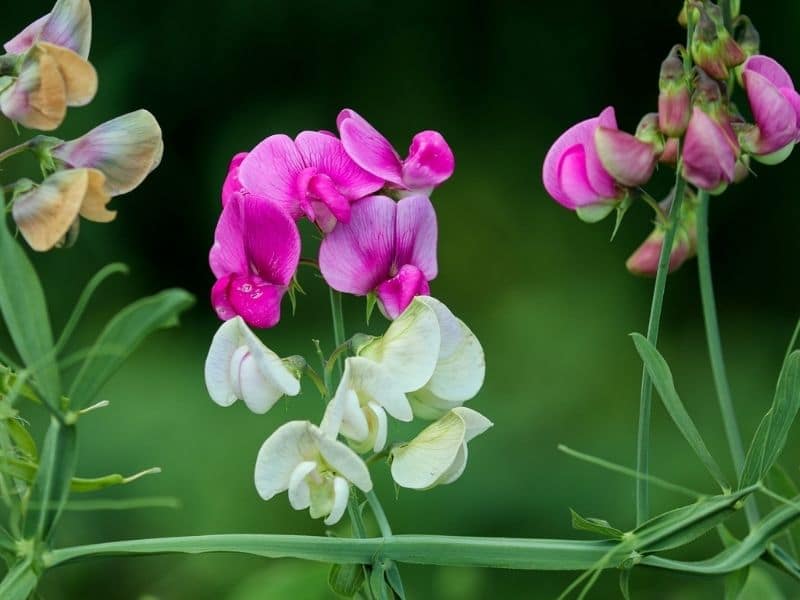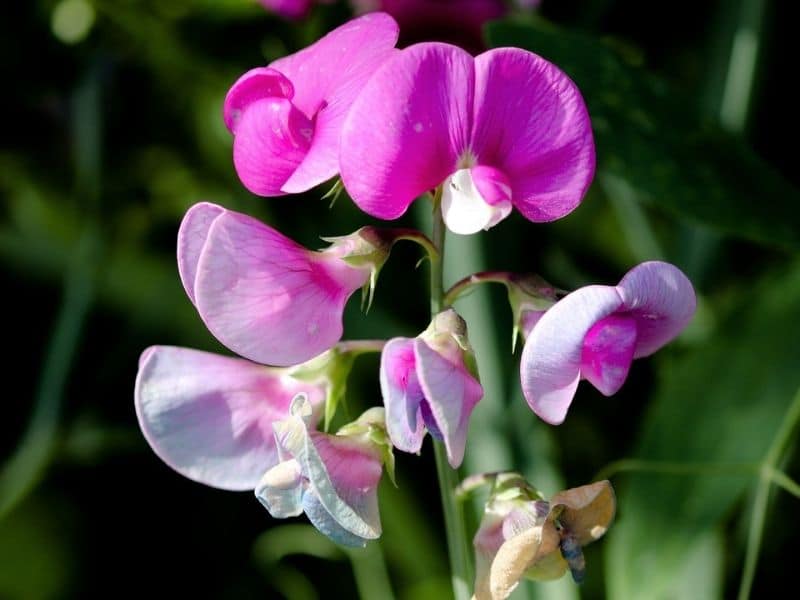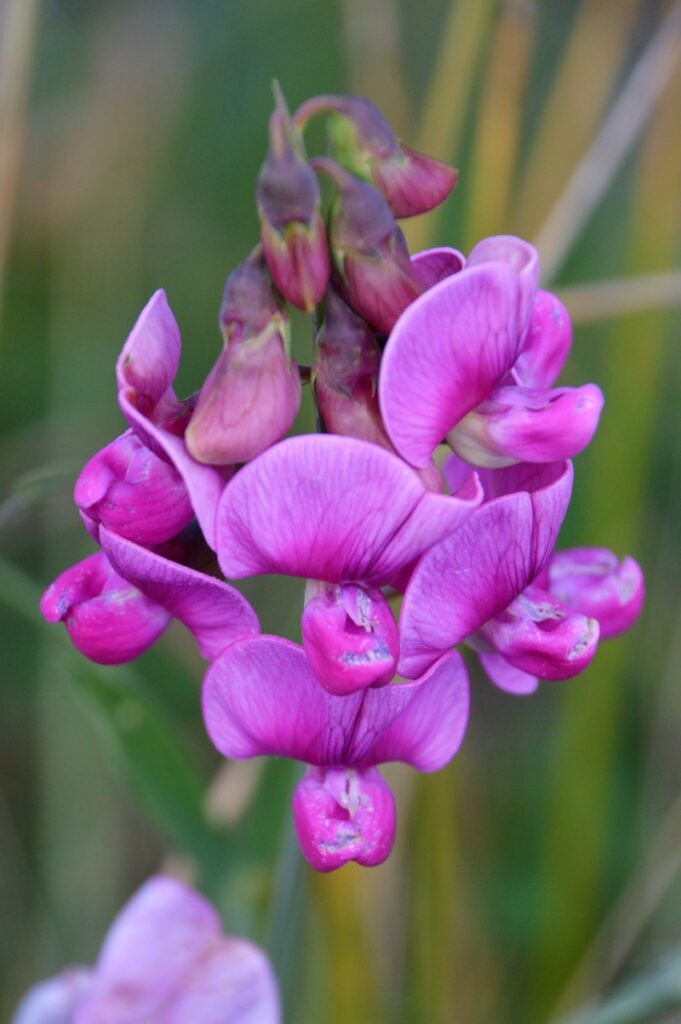Lathyrus odoratus, commonly known as the sweet pea flower, is an annual flowering plant grown for its fragrant and attractive blooms. You often see them beautifully arranged in bouquets or adding a nice pop of color in home gardens.
Read more below to know more about the different types of sweet peas, as well as some useful how-to-grow and care tips.
The Fragrant Sweet Pea Flowers and the Lathyrus Genus
Sweet pea or common sweet pea is an attractive ornamental plant native to southwest Italy and Sicily. It grows wells in a wide range of habitats, including roadsides, forests, and disturbed areas. It is considered invasive or possibly invasive in some areas because of its fast growth rate and climbing habit (1).
The fragrant plant comes from the Lathyrus genus in the legumes family (Fabaceae) (2). The Lathyrus genus has over 160 known species distributed in many parts of the globe, but mostly in the eastern Mediterranean region (1).

Aside from the common sweet pea, other recognized Lathyrus species include the following:
- Grass Pea or Indian Pea (L. sativus)
- Red Pea (L. cicera)
- Broad-leaved Sweet Pea (L. latifolius)
- Yellow Pea (L. aphaca)
- Spanish Vetchling (L. clymenum)
- Caley Pea (L. hirsutus)
- Flat Pea (L. sylvestris)
- Meadow Pea or Meadow Vetchling (L. pratensis)
- Tangier Pea (L. tingitanus)
- Beach Pea (L. japonicus)
The genus name Lathyrus originates from the Greek word Lathyros, which means “very passionate.” The species name odoratus, on the other hand, comes from a Latin word that translates to “fragrant” (3).
Plant Description
The common sweet pea is an annual climbing herb that grows up to 2.4 m in height. It features a vine-like stem that usually measures up to 1.8 m in length. The plant uses the tendrils at the leaf apex to climb into nearby vegetation (4).
The flowers come in various colors, including pink, white, red, purple, and violet. They are large, measuring up to 5 cm across, and borne singly or in clusters. The leaves are compound and arranged alternately. The leaflets are green and ovate-oblong to elliptic.
Uses
Sweet peas are popular ornamental plants in the home and commercial gardens. They are widely cultivated worldwide for flowers and fragrance. Their essential oil is used in perfume blends and cosmetic preparations (4).
Toxicity
The fruits and seeds of sweet peas are not edible. In fact, they are poisonous to humans if ingested (1). In particular, the seeds contain lathyrogens that can cause convulsions, paralysis, slow and weak pulse, and difficulty in breathing if consumed in large amounts for prolonged periods.

19 Best Cultivars of Sweet Pea Plants To Grow
Here are some popular types of Lathyrus odoratus you can grow:
‘Albutt Blue’
The Sweet Pea ‘Albutt Blue’ (Lathyrus odoratus ‘Albutt Blue’) is one of the most popular types of sweet peas grown in gardens. Acknowledged not just for its spectacular scent, this attractive climbing sweet pea variety flaunts delicate whitish-blue and purple-edged blooms and gray-green foliage. It typically grows up to 1.8 m tall with a spread of 0.5 m.
‘Almost Black’
‘Almost Black’ sweet peas are part of the Grandiflora variety series. They give a beautiful display of fragrant dark maroon, almost black flowers throughout the summer. They are commonly used in gardens and floral arrangements. The plant typically grows up to 2m and spreads up to 30cm. This variety is also known as “Little Black Dress.”
‘America’
The Lathyrus odoratus ‘America’ or ‘America’ Sweet Pea is an award-winning cultivar that grows up to 6 ft in height. It is a fast-growing climbing plant that features beautiful large flowers. Each flower typically measures about 1.5 inches in diameter, showcasing hints of reds on its delicate petals.
‘Black Knight’
Another intensely fragrant variety is the ‘Black Knight.’ It blooms all summer long, showcasing stunning dark maroon flowers in groups of three or four per stem. First introduced in 1898 by sweet pea breeder Eckford, it remains a popular cut flower today. The plant grows up to 6 ft in height and spreads up to 1 ft.
‘Bramdean’
Lathyrus odoratus ‘Bramdean’ is another popular modern Grandiflora variety of sweet peas. Known for its long stems and masses of ivory white blooms flushed with pink, ‘Bramdean’ continues to be one of the most beautiful types. It grows up to 6 ft tall. Like other sweet peas, this variety produces fragrant flowers.
‘Erewhon’
‘Erewhon’ sweet pea, otherwise known as the L. odoratus x belinensis ‘Erewhon’ is an unusual hybrid that features bi-colored flowers. Truly one-of-a-kind, this particular sweet pea flaunts a charming appeal with its mauve-pink and lavender-blue flowers. It’s also fragrant like most sweet pea varieties. The plant reaches up to 6 ft tall and 8” wide.
‘Fire and Ice’
Part of the Grandiflora series is the ‘Fire and Ice’ sweet pea, a highly fragrant and stunning sweet pea. This particular cultivar showcases beautifully colored blooms that are winged and ruffled. The plant is a vigorous climber, typically reaching about 6 to 8 ft as it matures.
‘Flora Norton’
Those looking for blue or purple flowers will enjoy the ‘Floro Norton’ sweet pea. The famed L. odoratus cultivar makes a lovely addition to gardens and floral arrangements with its impressive blooms. A crowd-favorite, this variety from the Grandiflora series is a recipient of the Royal Horticultural Society’s Award of Garden Merit in 1995.
‘Geranium Pink’
Sweet Pea ‘Geranium Pink’ is a Spencer-type that remains one of the most popular and widely cultivated L. odoratus. This variety frequents bouquets and summer garden shows as it is recognized for its clusters of large and frilly pink blooms and long stems. The plant grows up to about 4 to 6 ft and spreads to 2 ft.
‘Janet Scott’
A popular type of heirloom sweet peas is the ‘Janet Scott’ variety. When in full bloom, it displays light pink flowers that exude a delicate appeal and goes well with other flowers, whether in a garden or any floral arrangement. This famed sweet pea was introduced by W. A. Burpee in 1903. The plant grows about 4 ft in height at maturity.
‘Karen Louise’
‘Karen Louise’ sweet peas are known for their luxurious sprays of pale lavender blooms. The beautiful, fragrant flowers bloom throughout summer on long stems, adding a delightful sight to gardens or indoors in vases. This fast-growing variety grows up to 1.8 m tall and 0.45 m wide.
‘King Edward VII’
Another well-recognized variety is the Sweet Pea ‘King Edward VII.’ Also an heirloom Grandiflora sweet pea type, this collector-favorite impresses many with its strongly-fragrant crimson flowers that bloom throughout summer. More vigorous and taller than other varieties, the ‘King Edward VII’ grows up to 6 ft tall.
‘Lipstick’
Bright red flowers with wavy edges set the Sweet Pea ‘Lipstick’ apart from other popular varieties. This single-colored variety is a Spencer-type that boasts long flower stems (up to 27cm) and sweetly fragrant pea-like blossoms. Mature plants reach up to 7ft high.
‘Matucana’
Sweet Pea ‘Matucana’ is an award-winning variety recognized for its multicolored flowers and superb fragrance. In fact, it is dubbed as one of the strongest scented varieties of sweet peas. The plant produces up to four (4) large violet and deep crimson flowers per stem and grows up to 8 ft high. Aside from its attractive facade and fragrance, many gardeners prefer this variety because it is more heat tolerant than most sweet peas.
‘Mrs Collier’
Those looking for cream flowers should take a look at Sweet Pea ‘Mrs Collier.’ This lovely sweetpea is another highly fragrant variety that fills your home and garden with a relaxing scent. Part of the Eckford Grandiflora group, ‘Mrs Collier’ produces up to three lime to cream flowers per stem. The vigorous sweet pea vines grow up to 10 ft in height.
‘Pandemonium’
Unlike most varieties in this list, the ‘Pandemonium’ is a Spencer type that features pink and purple flowers with striking “flaked” details. Individual flowers are large with wavy edges, blooming on strong flower stems during early summer. The elegant plant is a vigorous climber, growing up to 1.8m high and spreading up to 30cm.
‘Prima Ballerina’
Sweet pea ‘Prima Ballerina’ is a popular variety that features lightly scented, tri-colored blooms. Each flower cluster flaunts a mix of three to four lilac, purple and pink-cream flowers with distinct veining details on the petals. This particular variety lasts long in the water, making them ideal as cut flowers. The plant grows up to about 1.8 m high and spreads up to 30 cm like most varieties.
‘Promiscuity’
L. odoratus ‘Promiscuity’ flaunts beautiful bi-colored flowers with a strong fragrance. You will see this variety in full bloom during summer, showcasing lovely blossoms ranging from pink to white and purple. Like the ‘Prima Ballerina,’ the ‘Promiscuity’ cultivar makes an excellent cut flower as it lasts long in the water. It reaches up to 1.8m tall.
‘St. George’
Another Spencer type in this list is the L. odoratus ‘St. George.’ This famed cultivar displays a mix of red and white flowers resembling the color of England’s flag. It is ideal as cut flowers or in beds and borders in gardens. Mature plants reach up to 1.8 m in height.

How to Care for Sweet Pea Plants
Although some find sweet peas challenging to grow, you can enjoy gardening with these fragrant ornamentals if you plant them in proper growing conditions and at the right time. Here’s a quick growing and caring guide to help with your cultivation.
Planting
L. odoratus or sweet peas can quickly grow from seed pods. The seeds are large, and most varieties are easy to germinate.
To grow sweet peas, sow seeds outdoors or indoors in winter or early spring, about six to eight weeks before the last frost. Before planting, soften the seed coat by soaking the seeds in water overnight. You can also nick the brown coating using a nail clipper before sowing.
Plant sweet pea seeds in a 4-inch pot at about 1 inch deep. If planting directly on the ground, sow in fall at 2 inches deep with 6 to 12 inches plant spacing. The seeds will germinate and grow in 10 to 14 days. For climbing types, prepare a trellis for added support.
Light
Sweet pea plants prefer full sun but tolerate partial shade. Growing them in full sun is advantageous as the condition leads to vigorous growth and good flower production. While these full sun annuals still grow in the shade, you can expect less flowering and less vibrant colors of the blossoms.
Soil
The fragrant flowering plant thrives best in fertile and well-drained soil. It also prefers slightly alkaline soil. Mulching helps keep the roots moist and cool.
Water
Regular watering is necessary for sweet peas to achieve optimum growth, especially during the warmer months. Lack of moisture may lead to faded flowers and wilting. When watering, water sweet peas from the base and avoid overhead watering as much as possible.
Hardiness
Sweet pea plants are hardy in USDA hardiness zones 2 to 11. Hard freezes can kill the plants, but not frost.
Fertilizing
As with other flowering plants, fertilization benefits sweet pea flowers. For best results, feed your plants with a high potash fertilizer or liquid fertilizer every 15 days.
Pruning
Although pruning is not necessary when growing sweet peas, regular deadheading is advisable to prolong flowering. Cut sweet pea flowers frequently and remove faded blooms to encourage a more extended season of bloom.
Common Pest and Diseases of Sweet Pea Flowers
Like any other plant, sweet peas attract insect pests and diseases that affect its growth and vigor. Young sweet pea plants, in particular, are a favorite of snails and slugs. These pests feed on the plant, including seedlings. However, they are easy to control through traps or chemical or organic methods.
Other common insect pests of sweet peas include aphids, pea weevils, pollen beetles, and thrips. Aphids are common insect pests of many plant species, causing plants’ damage by sucking the sap from healthy stems and leaves. The tiny insects also transmit viral diseases between plants.
Diseases caused by fungi, viruses and bacteria are also quite common in sweet peas. These include botrytis, crown gall, leaf gall, downy mildew, powdery mildew, root rot, cottony rot, streaks, pea mosaic virus, tomato spotted wilt virus, Fusarium wilt, Verticillium wilt, and more.
What can I plant with sweet peas?
When selecting companions for sweet peas, it’s crucial to consider factors that ensure mutual growth and garden health. Choose plants with similar soil, sunlight, and watering needs as sweet peas, which prefer well-drained, fertile soil, and full sun to partial shade.
These are some good options:
- Sweet alyssum
- Roses
- Lobelia
- Lavender
- Catmint
FAQs
Do sweet peas like sun or shade?
Sweet peas prefer full sun to partial shade, although they appreciate some afternoon shade in hotter climates. Providing them with at least 6 hours of sunlight per day encourages robust growth and abundant flowering.
How long do sweet pea flowers last?
Sweet pea flowers typically last for 5-7 days once they bloom, although this can vary depending on growing conditions, temperature, and the specific cultivar. Regular deadheading (removing spent flowers) can prolong the blooming period.
Do sweet pea flowers need a trellis?
Sweet pea flowers benefit from support such as a trellis, fence, or netting to climb and twine around. A trellis provides stability for the vines and helps showcase the flowers while preventing them from sprawling on the ground.
Do sweet peas like pots or ground?
Sweet peas can be grown both in pots and in the ground, but they generally thrive best when planted directly in the ground. Planting sweet peas in the ground allows their roots to spread and establish more freely, leading to healthier and more vigorous growth. However, they can also be grown successfully in large containers with proper support and well-draining soil.
Up next: Sweet Pea Flower Meaning and Symbolism
References
Reference list
- Lathyrus odoratus (sweet pea) (2020). Available at: https://www.cabi.org/isc/datasheet/31584#tosummaryOfInvasiveness
- Classification | USDA PLANTS (2020). Available at: https://plants.usda.gov/java/ClassificationServlet?source=display&classid=LAOD
- Fernald, M.L. 1950. Gray’s Manual of Botany, 8th ed. New York: American Book Company.
- Lathyrus odoratus | CLIMBERS (2013). Available at: http://climbers.lsa.umich.edu/?p=286
Close
*Featured photo by depositphotos.com/Elena281







